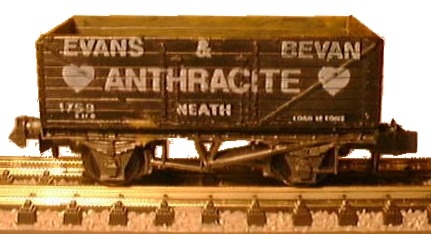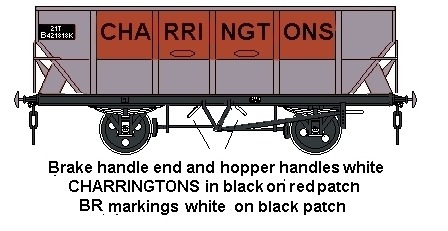Prior to World War Two the most common private owner type was the coal wagon. Pre-war Private Owner coal wagons fall into three groups, the largest fleets being the colliery wagons owned by the mines. Larger mines might have many hundreds of wagons and siding space was often a problem. The 'middle men' in the system were the colliery Agents, who sold the coal from groups of mines. These firms usually provided wagons of their own as well as using the colliery stock. Finally there is the local trader, who might have a fleet of as few as 4 wagons or as many as several dozen if he operated more than one yard.
Wagon building companies produced standard designs of coal wagon to Railway Clearing House specifications that were sold or leased out to traders. They were often supplied in the livery of the manufacturer, this being over-painted at some later date. Unfortunately no commercial models have yet used this dodge, which would alleviate the problem of finding an appropriate 'local' coal wagon for one's layout.
Transferring the coal directly from the railway wagon to the delivery vehicle was common practice as it saved the men having to lift the coal from the ground. It was therefore preferable for the coal merchant to use his own wagons as he would not have to pay the railway company for the demurrage whilst it was being unloaded.
In general the merchant's coal wagons seen in a small country yard would be those owned by a local coal merchant. In the summer season, when demand for house coal was light, the merchant might use the wagon for other business, for example dealing in building materials, or he might rent his wagon out, perhaps to a builder for whom the summer months could be busy. As local coal merchants tended to favour bright colours for their wagon side advertising we are constrained to use RTR rolling stock (there are some PO wagon transfers available). It is worth keeping an eye in second hand windows however, over the years the manufacturers ring the changes on the liveries and you may find some that suit your chosen location. The old Lima range is worth checking, the Lima chassis was not very good but the wagon bodies can be easily mounted on a Peco wagon chassis. You need to use a sharp knife to trim off the coupling locating pin from the upper section, if that fails use a 4mm length of Peco sleeper inserted top-side-down (they taper).
Fig___ Lima body on a Peco chassis

The colliery owned and colliery agents wagons did wander as people often specified a particular coal for a given job. For example it was usual to use Anthracite coal, (which is low in arsenic) in breweries or `maltings'. Anthracite has the highest carbon content of all the coals, anything from 89 to 98%, and gives the most heat when burned, about 14,000 British Thermal Units per pound weight. It was therefore the most expensive and tended to be used for specialised work. As the only sources of supply are South Wales and Scotland colliery wagons from these areas might turn up almost anywhere. A factory or small local trader would have to pay demurrage if the wagon was not unloaded within the regulation 48 hours.
One alternative is to use a Co-Op society as your local coal merchant. The Co-operative Wholesale Society was formed at the end of the 1850's and by the end of the century it had its own wagons repair works at Peterborough. This remained in operation right up until the mid 1960's, originally used for maintaining the CWS fleet of wagons (principally coal opens) and after Nationalisation for servicing stock for BR. The larger Societies had their own wagons, but the smaller concerns would be supplied by the CWS direct in CWS liveried wagons. I believe that at least in the late 1930's these were in a basic livery of green body with C.W.S. about 18 inches high on the sides in white shaded black and with the home depot (a large city) name in the lower right, the wagon number being in the lower left. One of the Hornby Minitrix 8 plank wagons is liveried for a local Co-operative Society (Millom) and it might be possible to re-paint the wagon to incorporate your own town name, not all the local Co-Op society wagons used the green body colour however. Bill Hudson's books on PO wagons (see bibliography) show several examples of Co-Op wagons.
As with the railway company general merchandise wagons there was a scheme for pooling private owner mineral wagons. This was introduced in the First World War and greatly reduced the movement of empty wagons on the system. This pool was primarily of interest to the large colliery owned fleets however, a local trader with just a couple of wagons would not have participated.
Operationally coal was generally moved as wagon load traffic. Block trains would run from the colliery to a marshaling yard but the wagons would then be forwarded to individual destinations. Some users such as larger power stations and gas works might warrant a block load and in the coal fields close to the coal exporting ports (or ports handling coastal shipping) block loads would be seen running to the docks. This latter traffic offered little advertising potential so the wagons used were usually plain black with the colliery initials and a number painted on in white.
Much of the coal ended up in small consignments at a local trader yard, the operation of these yards is considered in more detail in the section on Railway Goods Facilities - Coal.
At the outbreak of the Second World War the private owner coal, coke and iron ore wagons were requisitioned by the Government and pooled for the duration of the war. After the war these wagons were not returned to their owners but were purchased from them at a fixed price regardless of condition. There were some orders for new private owner wagons after the war but it soon became apparent that the Labour government was set on complete nationalisation of the railways and these orders petered out by 1948. Some of the new PO mineral wagons built immediately after the war remained in operation as PO wagons into the mid 1950's.
Most coal wagons from the late 1950's would be in BR livery although a few were in the wartime Ministry of Transport (MOT) livery (black with large white MOT initials on the sides). One point to note for wartime or post-war layouts is that requisitioned ex private owner end-door wagons had a diagonal white stripe painted over the existing livery right across the body, rising to the end with the door.
PO liveried coal wagons had virtually disappeared by the early 1960's but BR did paint some of its own wagons in the livery of major customers, one example being Charringtons who had a number of 21 ton hoppers carrying their name.
Fig___ BR 21 ton hopper in Charringtons Livery

There was a move in the early 1960's to eliminate the smaller coal traders yards from the railways, these required a disproportionate amount of shunting for the revenue they generated. As the goods yards closed down in the later 1960 and early 1970's BR adopted a policy of supplying a small number of purpose built 'coal concentration depots' from which the coal would be forwarded to traders by road.
To supply these coal concentration depots BR decided to adopt the hopper wagons and coal drops that had worked for the North Eastern Railway, one reason being that the hopper could be quickly discharged into the under track bunker, freeing the wagon for another run whilst the coal was bagged or transferred to tipper lorries for distribution.
As well as coal concentration depots BR also supplied a small number of industrial users and a few privately owned coal depots, an example of which from the air braked era has been sketched in the section on Freight Operations - Air Braked Network, Speedlink and Enterprise wagon load services. All deliveries to these depots were in BR owned hoppers (originally the 21 ton types, later the air braked HBA type).
In the 1980's containerisation was applied to coal, the containers were built by Cobra and the early 20 foot long types ran as block loads on purpose built drop centre wagons between the mines in South Wales and the docks for export to Ireland. Later a low height 30 foot container was developed which ran on privately owned air braked chassis (redundant BR built chassis were used for these). I believe some of these longer coal containers were moved in Speedlink services for delivery to outlying depots in Scotland. The containers themselves were painted in the operating company livery. These are described in more detail in the section on Freight Operations - Coal.
Following Privatisation National Power (the privatised electricity generating company) invested in high capacity bogie hopper wagons, replacing the BR built HAA merry go round wagons on some services. I believe these were later sold and I am not sure what arrangements currently exist for merry go round coal deliveries.